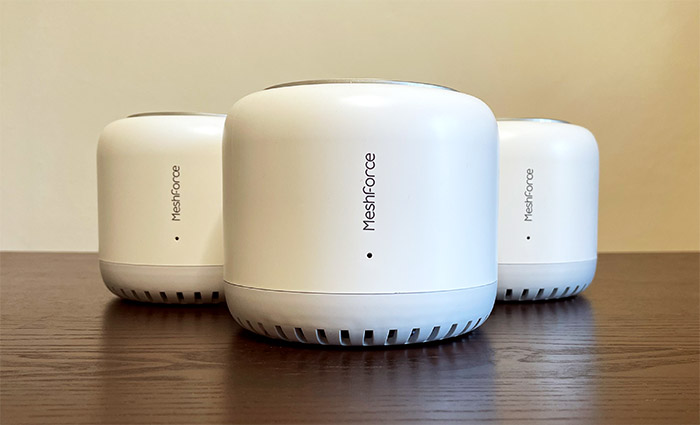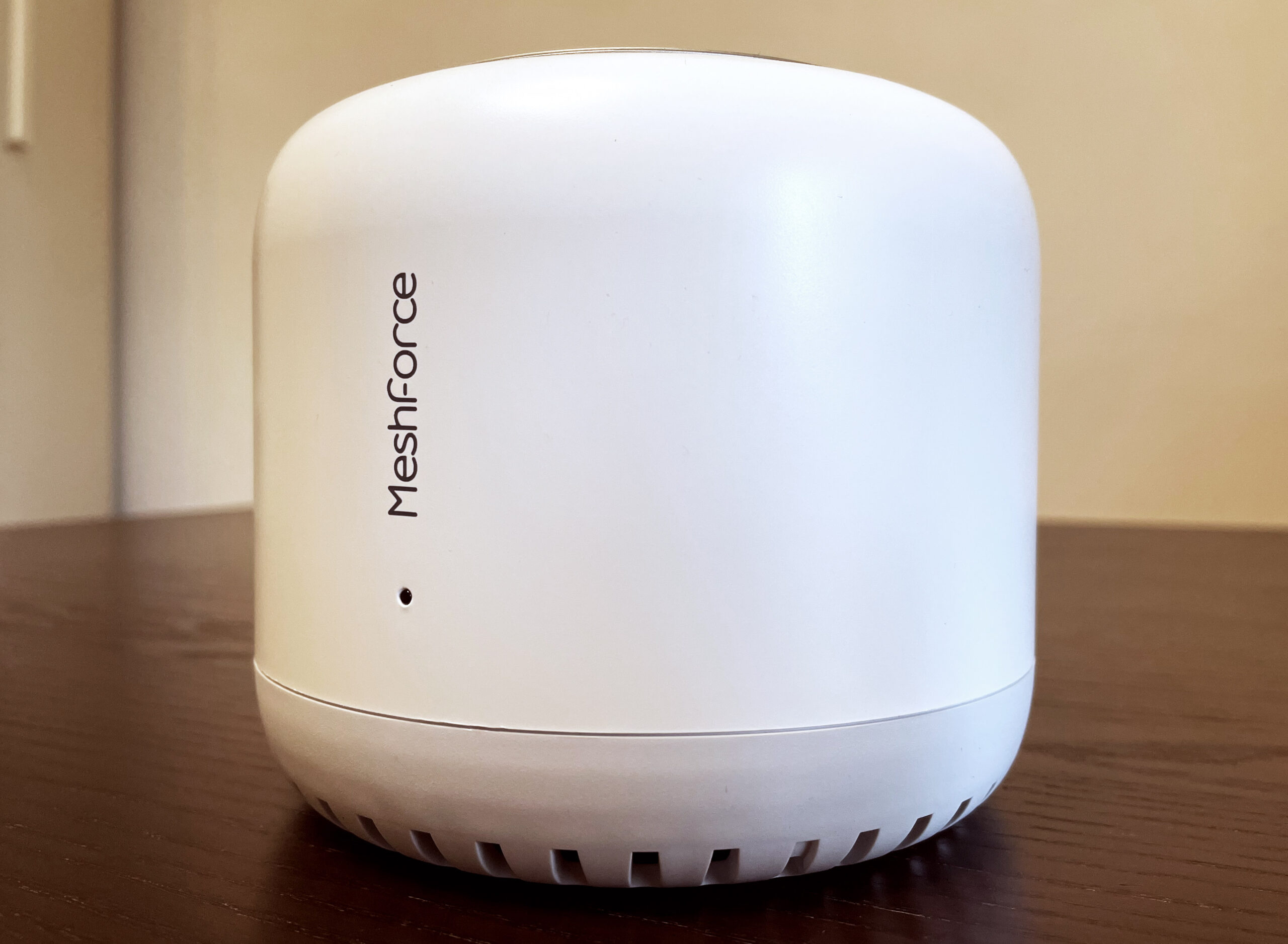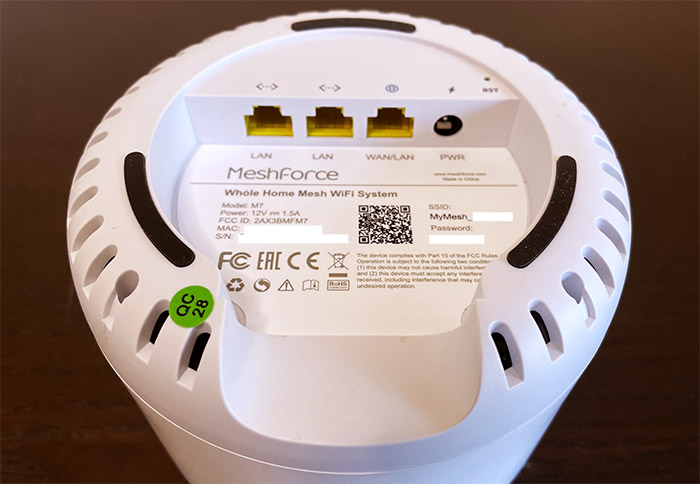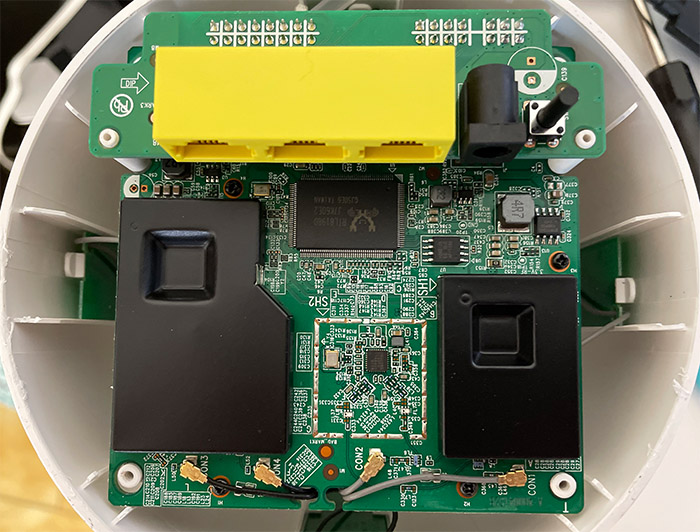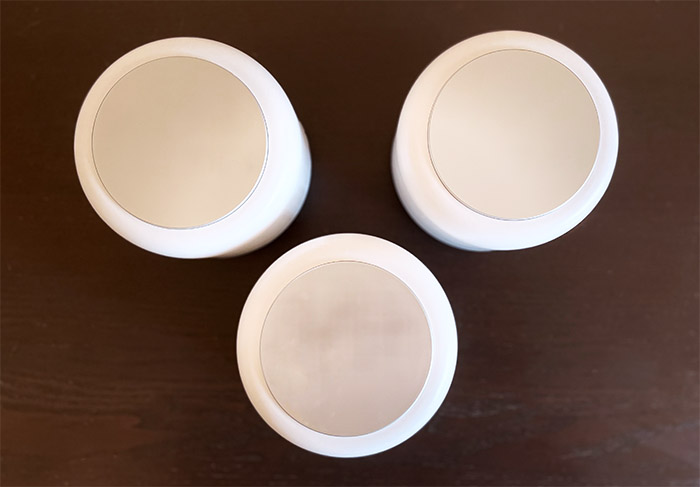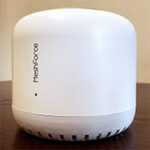The Meshforce M7 is (currently) the newest WiFi 5 mesh system developed by the Chinese manufacturer and we’re dealing with three identical units that rely on a dedicated 5GHz radio band to handle the backhaul traffic (yes, all three units are tri-band).
I have seen this approach years ago when the first gen Orbi was released, followed by the Linksys Velop and the Zyxel Multy X, but it seems that these big brands have almost completely moved on to the newer WiFi 6 standard. And the Meshforce’s M7 aim is to cover the market segment that’s left behind by these manufacturers – unsurprisingly, this is a fairly large segment. That’s because a good tri-band WiFi 5 mesh system is very much relevant today, even if the WiFi 6 standard is already gaining more ground (apparently, in parallel to the WiFi 6E).
This is due to other manufacturers which aren’t adding AX adapters into their mid-range and cheaper electronic devices anytime soon (which is like 80-90 percent of all WiFi-ready electronic devices). So, that’s where the Meshforce M7 comes into play, offering a full-home coverage using (a variant of) the mesh technology, Beamforming, MU-MIMO and it also does promise to make the installation and the configuration process as simple as possible. Price-wise, it does stand slightly cheaper than other similar devices, so let’s put it to the test and see if it can be considered a better option than its main competitors.
Design and Build Quality
The first tri-band mesh systems had huge units and the likes of Velop and Orbi would look more like a vase than a router. Later, the Eero Pro and the TP-Link Deco M9 Plus got significantly smaller, while delivering a very similar WiFi performance. The Meshforce M7 is somewhere in between because its three identical units have a fairly small footprint (comparable to a Deco), but they’re a bit taller than the likes of Google WiFi. Indeed, each unit measures 5.2 x 4.3 inches (13.0 x 11.0 cm) and yes, the shape of a Meshforce M7 unit is cylindrical. Each device is covered by a white matte finish, with a silver section at the top and a light gray soft plastic bottom part. I noticed that the M7 does have some silicone feet, but each unit remains quite slippery.
I think that the main reason is that each M7 device is very lightweight and I have opened one up to see that besides the PCB, the rest of the case is pretty much empty. The good news is that this way, the Meshforce M7 should have a good heat management. And indeed it does, as I only felt a bit of heat at the top of the unit – I need to mention that the bottom part has a circular pattern of holes for allowing the heat to escape the device. So yeah, the M7 units are fairly cool, especially when left in the open. While I do appreciate the fact that the mesh WiFi systems look great and will beautifully compliment a room, we have lost one important design feature and that’s the possibility to wall mount them. As expected, this is also the case with the Meshforce M7 units, since there is no mounting hole at the bottom.
Furthermore, another design element that got less functional is the LED indicators. While the regular router usually has an array of LEDs, each accurately showing the status of a specific function, the mesh systems either have a large ring of light or a single small LED that shines in various colors. Sure, we have been conditioned to associate red with bad and blue/green with good when it comes to electronics, but that’s not how all manufacturers use their single LED. No at all, we usually get the entire rainbow because pretty lights. In any case, each Meshforce unit has a single small LED underneath the logo (from the side) and, when it’s solid green, it means that the Internet connection has been successful. If it’s solid yellow, then the Internet connection is fair. If the LED flashes green, then the device is ready to be set up and if it’s solid red, then either the set up process failed or the unit is unable to connect to the Internet.
If you turn any of the three Meshforce M7 units upside down, you will be able to see a dedicated area for the ports and inside it, there’s a Power connector (the adapters come into the box), a WAN/LAN port (this port can be used as WAN if we’re dealing with the main unit, while on the mesh nodes, it’s simply going to work as LAN) and two LAN ports. I am actually impressed that we get two additional LAN ports since most manufacturers don’t bother with anything above the single WAN/LAN port. Lastly, there’s the recessed Reset button that you need to press for 10 seconds to return the device to factory default settings.
Internal Hardware
If you got the three-pack Meshforce M7, as I did, know that all units are completely identical, so I chose one of them and attempted to open it up. Be aware that doing so will most likely void the warranty, but I didn’t care so I moved on. The very first step is to turn the unit upside down and identify the four circular holes – I admit I did not notice them and went crazy with a prying tool until I realized that there are screws that keep the bottom section in place. Don’t do as I did, just remove the four screws and then carefully detach the top section. This way, you will be greeted by the fairly small main PCB, as well as the smaller board that sits on top of it. Overall, the case is pretty much empty, but I did notice the four antennas that point upwards to the sides of the hollow part of the case.
| Meshforce M7 | TaoTronics TT-ND001 | |
| CPU | dual-core 1GHz Realtek RTL8198D | dual-core 880MHz Mediatek MT7621AT |
| RAM | 256MB | 256MB Nanya NT5CC128M16JR-EK |
| Storage | 64MB H25S128 | 128MB Winbond W29N01HVSINA |
| Switch | Realtek 8192FU | – |
| 5GHz Radio | Realtek RTL8812FR 802.11a/b/g/n+ac 2×2:2 | Mediatek ARM MT7615N 802.11ac 4×4:4 |
| 2.4GHz Radio | Realtek RTL8812FR 802.11b/g/n 2×2:2 | Mediatek ARM MT7615DN 801.11b/g/n 2×2:2 |
The main PCB has a couple of aluminum covers and after removing them, these are the components that I was able to identify. I saw a dual-core 1GHz Realtek RTL8198D J7K60E2 (ARM architecture – Cortex-A17), 256MB of RAM (strangely missed it on the board), 64MB of flash memory (H25S128), a Realtek 8192FU wireless LAN 802.11n USB 2.0 Network Adapter and a ZTP7194S synchronous step-down DC/DC converter. For WiFi, the Meshforce M7 relies on the Realtek RTL8812FR highly integrated single-chip 802.11a/b/g/n+ac, 2×2:2 along with two SKY85743-21 highly integrated front-end modules for the 5GHz radio and another Realtek RTL8812FR K514QP1 chip (802.11b/g/n 2×2:2) for the 2.4GHz radio band.
Note: Each Meshforce M7 unit is an AC2100-class router, so it features a maximum theoretical data transfer rate of 300Mbps on the 2.4GHz radio band and a maximum theoretical data transfer rate of 867Mbps on both the first and on the second 5GHz band. These are results measured in a lab in ideal conditions, so don’t expect to get very close to these values in real life.
Features and Performance
While I haven’t yet tested any 802.11ax mesh system, I have checked out almost every WiFi 5 system out there and all had in common one main feature: the ability to create a mesh network. That’s essentially the point of getting multiple units and scatter them around the house, since you need them to wirelessly connect between each other and create a single network, where the client won’t really show that it moves from one device to the other. And this is possible due to a form of mesh network, where one unit connects to the modem to gain access to the Internet (via cable, obviously), while the second and, perhaps the third unit will connect to the main device wirelessly. There are a couple of properties that I need to highlight and the first is the auto-healing ability which means that if a node fails (goes offline), you don’t get immediately disconnected from the Internet.
And that’s because the next suitable node will take over and move the data to and from your client device. The second property is the ability to automatically optimize the path for your data, so you are always connected to the least crowded node that has the most suitable signal strength.
Of course, this is the ideal and things aren’t always working as intended (the Netgear Orbi was notorious for its unstable features, but strong performance). Now, if you go over one hop and connect to the first satellite, everything should be fine due to the dedicated 5GHz band. Yes, the Meshforce M7 allows the clients to connect to the 2.4GHz and one of the 5GHz networks, while one band is left only for the backhaul traffic.
I have seen this approach on the Orbi and Multy X and it worked really well. But, if you decide to connect to a mesh node that’s two hops away from the main unit, there will be less bandwidth for your devices. So, I suggest to put the main M7 unit in the middle and put one node to one side, while the other will better sit on the other side of your home. If you do have Ethernet cabling available in your home, you could rely on the Ethernet Backhaul feature and connect the units via cable, although that would essentially defeat the purpose of a WiFi mesh network. But it will definitely help with the speed.
Meshforce M7
-Pros
- Decent wireless performance on the 5GHz band
- Two extra LAN ports on every M7 unit
- The dedicated 5GHz band works as intended
- Although not the most compact, the M7 is still fairly discreet due to the lack of flashy LED lights
- Quite affordable
Cons
- There is very limited amount of configuration available
- The Parental Controls and the QoS are anemic
- No web-based GUI
- The silicone feet are unreliable

Mark is a graduate in Computer Science, having gathered valuable experience over the years working in IT as a programmer. Mark is also the main tech writer for MBReviews.com, covering not only his passion, the networking devices, but also other cool electronic gadgets that you may find useful for your every day life.

